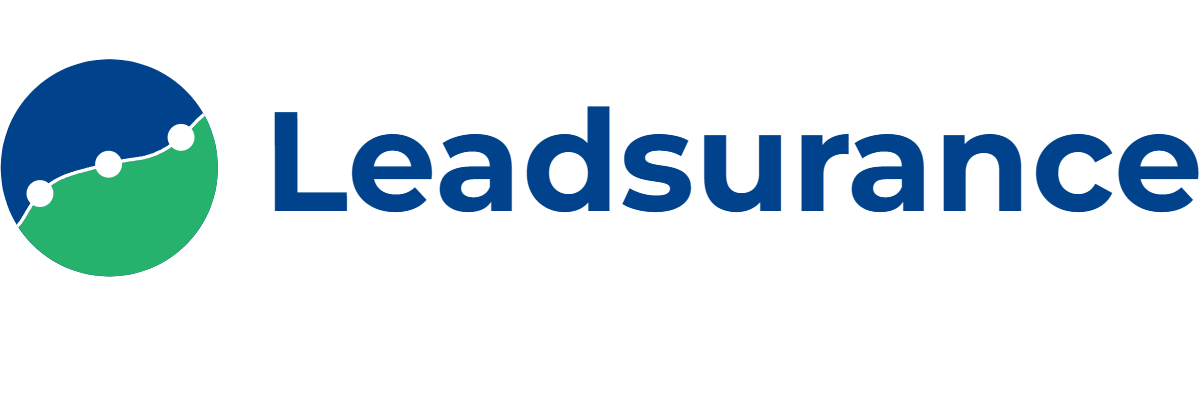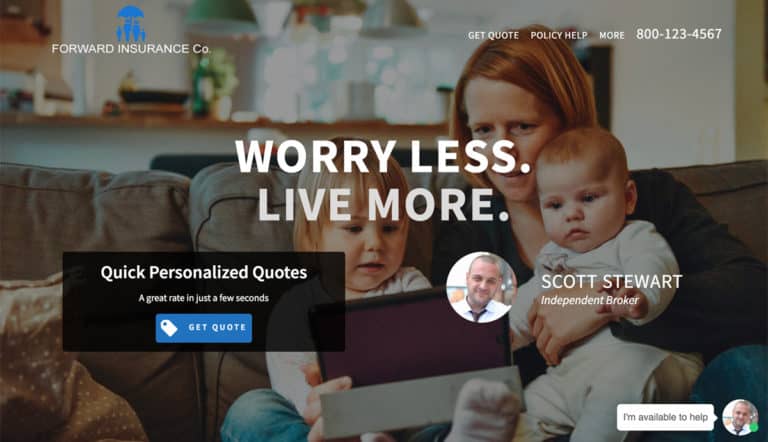Any good insurance agent knows how important a sales pipeline full of insurance leads is for their business.
But when it comes to insurance lead management, even good insurance agents are leaving money on the table.
So, in today’s post, we are going to share 15 insurance lead management tips to help you sell more policies.
These tips will increase your sales conversion rate with new leads as well as up-sells, cross-sells, and referrals.
Plus the tips are backed by some real examples from insurance agencies using them at the end of this post.
Note: We surveyed insurance professionals around the country who helped us put together this list of tips and we have also included some examples of their exact insurance lead management systems and processes at the bottom of the post.
Create Valuable Content Targeting Your Buyers
This first tip is about generating insurance leads into your lead management process.
Insurance agents, agencies and any small to medium-sized business have to be focused on generating inbound leads.
Inbound lead generation should be done efficiently because it will directly feed into your insurance lead management process.
Content creation and digital marketing are some of the best methods for generating insurance leads.
In this age, it is not uncommon for successful insurance agency owners to learn about SEO and PPC and even get Google Ads certified.
At the very least insurance agents should understand and deploy landing pages and sales funnels, and use a CRM.
You don’t need an expensive insurance lead management software system but also not just any generic CRM.
Find a CRM for insurance agents that facilitates your specific actions with your leads. (i.e.- automated welcome text, email drip campaign inside of X amount of days to close X% of new leads, policy expiration dates and more).

Want to deliver value to your clients? Then create useful content that educates them and provides real value.
With an outbound strategy accounted for you must start an inbound content strategy.
With a content strategy in place, you can then consistently create SEO optimized content and support your content with link building and social media promotion.
Consistently delivering value through content creation will lead to a higher quantity and quality of inbound leads.
Before you start blogging weekly, the first step to great content creation is creating buyer personas to help you understand the type of content your customers need.
Track the Customer Journey
After building your buyer personas, define leads by interest and intent.
This allows you to decipher where your customers are on their journey and the type of content and how much nurturing they need.
Then, you can assign leads to drip campaigns (emails that drip different content to leads in different buckets over time).
For leads who aren’t ready to buy, placing them in the correct lead nurturing buckets will keep your brand top of mind.
Ensure your scoring system is in place to determine where your customer is on their journey, and ensure that it’s updated and equates the correct scores to the level of intent to purchase.
This will help determine if they are qualified to be handed off to sales or if they need more nurturing.
Lastly, track which programs generated which leads and the result of their customer journey which will inform you of all types of other pertinent information.
This insurance lead management tip comes from Omar R. Fonseca, medicareplanfinder.com
Test Your Lead Gen Forms
When it comes to online insurance lead management, testing and optimizing your lead generation forms is essential for improving your lead management process.
Similar to insurance lead generation forms, one of the major obstacles surrounding the creation of a lead generation platform for a financial advising or legal business is the difficulty in creating a qualified lead for the end-user that is fully completed by the consumer.
A ‘qualified lead’ must acquire enough information to make the lead useful but not demand so much information that the consumer does not want to complete the form.
It is an art to find that right balance between how many fields that you can expect a user to complete before they bounce from the form without completing the entirety of the application.
We have found that for most legal, financial, and insurance related web forms that a consumer will fill out no more than 9 fields before deciding to bounce from the questionnaire, so it is critical to keep the form short and easy.
This insurance lead management tip comes from David Reischer, Esq., LegalAdvice.com
Immediate Follow Up
Following up with a lead is finicky and the only tried and true rule we use at our agency is urgency.
The first follow up doesn’t have to be a phone call although this is ideal, an email is also great especially if it mentions a phone call that is coming soon.
The quicker you follow up with a lead, the better your odds of conversion. As for the process, documentation is king.
What we see with a lot of the companies that outsource to us is that they don’t even have a CRM to keep track of leads.
You need to be logging every single interaction with every single lead, software like Zoho or Salesforce have integrations with call technology like Dialpad or Aircall which can make the process easier.
This insurance lead management tip comes from Michael Sheen, kinectcorp.org
Call Leads Today
Like we just discussed, when it comes to converting leads, timing is key.
Which is why you should be calling new leads ASAP, even if you have an automated email that goes out to them immediately.
The sooner that you follow up with your new leads after they first request information from you, the better chance you will have to make a connection.
Due to the speed of technology these days, consumers are expecting an immediate response more than ever.
On the other hand, the longer you wait to contact them, the colder leads will become.
That is particularly true when it comes to seniors, who might forget they asked for information about Medicare Supplements or Final Expense Insurance by the time the agent finally calls them back.
Timing can mean the difference between you looking like a suspicious spammer or a helpful agent who is responding to your call for help.
- Introduce yourself by your name
- Introduction your company’s name
- Explain why you are calling, either to help the person save money on their Medicare Supplement, or help ensure their loved ones do not inherit the debt from their final expenses.
- Get a clear timeline set for the following steps
Be Persistent About Calling Back
There is a very line between being pushy and persistent, so the frequency of your follow-up cam sometimes be tricky.
Typically the standard is about 48 hours between each of your calls. During the first week, agents might call every day, then for a couple of weeks after that, about every third day.
If prospects do not respond after a specific number of calls, then agents may want to try taking a different approach, such as door-knocking, direct mail, or email.
Leave or Don’t Leave a Voicemail
Some agents feel obligated to leave a voicemail each time they attempt to call a lead.
Other agents completely skip leaving messages and rely on leads being curious and calling them back to learn more after Google the phone number online.
Then others may leave a message only ever three tries or so, attempting to strike a balance between not being too annoying and being persistence.
These days, around 77% of senior citizens have cellphones, which is more than ever before. Even people who have landlines still most likely have caller ID, you can safely assume that a majority of seniors will see that you attempted to call.
- It is a professional courtesy. Other professionals (doctors, realtors, accountants, dentists) leave a voicemail whenever they make calls. On the other hand, typically spammers don’t since they are hoping to catch people off-guard.
- This puts the ball into your lead’s court to return your call, which if they are taking the initiative, qualifies their interest.
There are some agents who would prefer to get their prospects to answer their call, rather than leaving messages that can give them a reason for screening their calls in the future.
However, leaving a message may make your leads suspicious and think you are attempting to catch them off-guard.
Remember, seniors are taught that they should be suspicious of individuals taking advantage of them, particularly regarding financial matters such as health care and insurance.
When you leave a message it shows you are a professional who sincerely wants to help them with solving a problem that they have acknowledged that they have already.
Get a Sales Pipeline Created for Follow-up
It, of course, makes sense for you to focus your attention on your hot leads who are ready to buy.
However, that doesn’t mean you should neglect your warm leads or even your colder leads who are at the top part of the funnel.
If you are not able to connect with your leads after you leave several voicemail messages, then try to use a different channel and add them to your sales pipeline so that you can follow up after a couple of months or weeks.
When you stay in touch, you may be able to catch leads after their lives change and their interest is reignited.
This may be either because they had a birthday recently that increased their rate or their health did not qualify them the first time you called them.
Life circumstances change, so it is important to stay in touch and follow up.
Take Notes
Taking detailed notes on every conversation you have with your leads will put you in a better position for your follow up.
When you are calling many leads every day and having similar conversations, having detailed notes can be useful reminders about each of your prospect’s unique circumstances and where they are located in the sales cycle.
That allows you, or another agent or assistant on your team, to pick up on your conversation easily where you left off.
That goes beyond your lead management system’s “official” notes about the prospect’s current plan details and health conditions and includes more detailed notes on who they are.
- Family members (their names and interests – for example, if a prospect mentions that she is going to attend her grandson’s baseball game)
- Friends (who might be possible referrals)
- Recreational activities or hobbies (which can help you get common ground established with a prospect)
- Volunteer or work commitments (which may indicate when they are available if you know they babysit their grandchildren every Friday morning or they work most of the weekday afternoons)
As useful as your notes might be, it also can show your prospects you care enough and paid attention to remember some personal details about them.
When you mention details or names from previous conversations, it shows you were listening to them and remind prospects that you have an established relationship already.
Prioritize Leads and Communicate Accordingly
Prioritize your inbound leads into three separate tiers, and create specific nurture cadences for each of those tiers.
The accounts in your highest tier – those that would be most valuable to win – should have more touchpoints and where you should focus the most effort.
These accounts should receive more personalized attention – instead of a template email, they’ll receive customized messaging.
Custom messages are things like short, intro videos from a sales rep that speaks to their specific needs or a custom written proposal that clearly defines your offering and the benefits they can expect in working with you.
Using this type of account-based marketing (ABM) strategy helps to make the best use of limited resources, while also acting as a reminder that not all accounts will have the same long-term value to your business.
This insurance lead management tip comes from Emma Valentiner, LeadCrunch
Leverage Your Multi-Channel Touch-Points
It requires multiple touches before leads become customers. You will hear quite often that it takes 8 touches on average before a sale but there is other research that states this number might even be higher.
The BASHO sequence by Jeff Hoffman is one popular method, which entails a series of four voicemail-email combination touches, which range from “introductory” to “persistent.”
If the prospect does not respond to any of your first three attempts, then there is “break-up” phone call/email that is attempted – which generates a very good response rate quite often.
Industry surveys report that insurance agents make 5-8 calls on average to telemarketed leads.
There are some agents that move on after just 3 calls, while others make up to 15 calls before they do, and then there are some that continue to try after that.
Nearly 25% of agents who were surveyed claim that they keep leads indefinitely in their pipeline (or as one agent said, “until they die or buy.”)
Unless you ask a prospect directly which mode of communication is preferable to them (which is a good idea), you may not know which of the channels they are the most likely to respond. Contact often and call early, and then use as many different avenues that are necessary to contact your leads.
Try to call, email, knock on doors, if your leads live close by. Sending a letter or card can add a nice personal touch that in this digital era is increasingly rare.
Differentiate Yourself
If one of your leads has returned your direct mail card or responded to your telemarketing call, there is a good chance that she has most likely responded to other marketing requests also.
Either way, most likely she has heard about other options to save money on Medicare Supplements or take care of her final expenses – whether she is taking with her friends at the hair salon or watching commercials on TV.
The point is, more likely you are not the only one who is speaking to her about her insurance options.
In order to stand out and have a good chance of prospects staying in your pipeline rather than them leaking into the grasp of another agent, it is important for you to differentiate yourself from all of the other agents.
Even if the solution you offer can save a prospect more money, keep in mind that the only differentiator is not price. In fact, if you lead with the price, the prospect might think that the commission is all you care about.
You really want to set yourself apart based on service, by showing seniors you really do care about them and will go the extra mile to help them.
Don’t forget what we said previously about your sales cycle aligning with the buying prospect of the prospect.
Be persistent. While other agents may give up after making 3 or 5 calls, if you send a birthday card to someone five years later, then whenever her insurance needs change, you will be in the front of her mind.
Add value to each touch-point. Rather than just calling someone to follow up, look for ways that can value to every email, card, or call. Mail out a rate comparison of the various options they are considering, email a useful case study that shows how a client save money or discuss a news article on the changes to Medicare.
Automated email campaigns should be used to send education marketing materials over time to prospects, instead of having to reinvent the wheel constantly. Although the bottom part of the funnel may focus on sales, most of the sales pipeline management that you make should focus on educating more than selling.
Inject humor to help to defuse any potential pressure to buy. When humor is handled in an appropriate way it can help make the mood lighter when talking about a topic that is otherwise heavy, such as funeral expenses and medical bills.
Try a Phone Answering Service
If your business relies on a large proportion of phone leads, consider investing in a phone answering service.
Basic phone answering services can offer 24-hour coverage without significantly increasing your overhead, which otherwise can be a bottleneck for growing service businesses.
Virtual receptionists take it a few steps further by also offering services like confirming sales orders, technical support, appointment scheduling, and more.
There are insurance answering services available that can begin the phone call and transfer the call over to you when you’re available or take a message if not.
This insurance lead management tip comes from Joe Goldstein, ContractorCalls
Build A Strong Online Brand
In the current digital era, insurance agents cannot afford to ignore the internet. Increasingly, your online presence plays an essential role in your brand recognition and overall reputation.
- Capture the attention of prospects
- Increase brand awareness to remain top-of-mind
- Raise your credibility
- Differentiate yourself from your competitors
- Generate free online leads
- Amplify your traditional Medicare and life insurance marketing efforts, to prospects somewhere to get more information after receiving a phone call or mailer from you
- Build trust (a critical ingredient for all sales pipelines)
- Educate consumers about the solutions you have to offer
Building a strong online brand begins with an optimized insurance website design.
Close Each Follow-up You Make with a Call-to-Action
Your next steps should be made very clear so that your prospects know what they can expect from you.
- Do you want them to go to your website and download a whitepaper to get more information on Plan F before you call them again?
- Should they be on the lookout for a package that you are mailing to them?
- Are you wanting them to return your call, or wait for you to return their call at a certain time and date?
Tell prospects what you would like them to do in order to progress into the next stage of your sales pipeline that moves things closer to a sale and towards them saving money (or their peace of mind) that is offered by your solution.
* Examples of Insurance Lead Management Processes *
In this section, we will share a few real-life examples of financial advising and insurance lead management processes that are used by advisors and insurance agents around the country.
Life Insurance Lead Management Example
In my opinion, it’s very important to have leads automatically transfer into a crm that has the capability to send out emails and texts. When a person fills out a quote form on our website, that person’s contact info feeds into a crm. Then the crm sends out an email saying that we received their inquiry and will reach out shortly to answer any questions.
If they don’t answer when I call, I leave a voicemail and my crm sends a text message also. I let them know that I can help them by shopping many insurance companies, on their behalf, to save them time and money on this important purchase.
I’ll typically call twice a day for 5 days. Every other call they’ll receive an email also and a couple texts during the calling period. If we don’t connect, then a drip-email campaign launches. These emails are a combination of education on the life insurance process and gently nudging them to reach out to us so we can help them get life insurance.
It’s very important to automate as much of this as possible. I use Vanillasoft as my crm and convertkit for email drip campaigns.
*Bottom Line:* Automation and consistent follow up by call, email and text are keys to turning leads into clients.
Chris Abrams, abramsinc.com
Income Protection & Insurance Lead Management Example
Managing inbound leads can be a daunting task that can easily get out of hand if you don’t have the proper systems in place.
When a prospect completes one of our online forms, several things happen.
First off, the lead is automatically imported into our CRM and our rules-based system creates tasks for the agent responsible for the follow-up.
Second, a text message immediately goes out telling the prospect that their information was received and that we are sending them an email (which goes out 5 minutes later) with a few more questions. The goal in doing so is to have them stop entering their information into other websites and to respond to our email.
And finally, the agent calls as soon as possible. We try to make phone contact with the prospect several times in the first few days, but in many cases, we are already communicating with them via email where we can start building trust and credibility.
If none of this is successful, we have a drip campaign that is set up in our CRM which includes emails, phone calls, and texts. We are really only looking for people who want to buy now so this process is only three weeks, after which we mark the lead as dead.
Raymer Malone, Owner – highincomeprotection.com
Enterprise Insurance Agency Lead Management Example
Back when I worked with some of the top insurers in France, I ran some analysis to help them optimize their quote-to-customer conversion rate.
We noticed something that was hidden in plain sight, which helped us optimize the overall conversion rate: their agents (and we’re talking about thousands of local agents) had lower conversion rates from Friday afternoon to Monday morning.
Nothing out of the ordinary if you think about it since no one was answering quotes on weekends. We deep-dived and learned from customers that some insurance products (like health insurance) need a quick answer. Qualified leads stayed qualified for 12 to 24 hours, after that it was too late.
We decided to implement different strategies to help agents optimize their lead pipeline during weekends: lower media coverage these days, marketing automation to keep the lead qualified a little longer, and external sales team that worked on extended office hours. It worked pretty well!
Guillaume Robez, independant.io
Loans & Financing Lead Management Example
My best tip to help manage in-bound client applications would be to make sure that you communicate with applicants quickly.
Specifically, my firm has a 30-minute callback time on any inbound applications. This ensures that we secure the client relationship and get them into our service pipeline as quickly as possible.
After our account managers pre-qualify an applicant, the client information is then inputted into our proprietary CRM which then provides the account manager with updates and notifications to communicate to the client.
The biggest complaint we see from clients in our business is that they are not updated on their application status in a timely manner. We eliminate this with daily messages, and immediate phone calls whenever an issue arises. Client service is extremely important to my firm and managing the incoming client pipeline is a key to our continued success.
Daniel A. DiGiaimo, bakerstreetfunding.com
Insurance Lead Management Takeaways
Alright, if you made it this far go ahead and pat yourself on the back because you’re now an expert at lead management for insurance agents.
That was nearly 3,500 words of expert advice from insurance lead generation experts and some great insurance sales agents around the country.
These folks are in the trenches daily and are experts at insurance lead management so let’s wrap up with their most important takeaways.
- Provide Value: Having a fully functional useful insurance website with helpful educational and valuable content will attract your target buyers and help build trust driving more leads.
- Respond immediately: We know that the quicker you respond the higher your conversion rate. You can start with an immediate automated email or text followed quickly by a phone call from your sales team.
- Keep following up: Most sales take at least 5-7 touches before closing so make sure to continue following up with leads at least 7 times.
- Use a CRM + Automation: Your CRM should be capturing every touch and conversation that occurs while leveraging automation to continue on to the next touch point.
If you have an insurance lead management tip that we left out, it would be awesome if you shared it in the comments below!
Want More Insurance Leads?
Try our instant quoting insurance chatbot to claim 3 free exclusive insurance leads.






